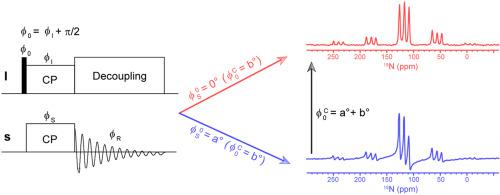Solid State Nuclear Magnetic Resonance ( IF 3.2 ) Pub Date : 2021-12-23 , DOI: 10.1016/j.ssnmr.2021.101771 S Chandra Shekar 1 , Wancheng Zhao 1 , Thomas K Weldeghiorghis 1 , Tuo Wang 1

|
Utilizing phases of radio frequency (RF) pulses to manipulate spin dynamics is routine in NMR and MRI, leading to spectacular techniques like phase cycling. In a very different area, cross polarization (CP) also has a long history as part of a vast number of solid-state NMR pulse sequences. However, a detailed study devoted to the effect of CP RF phases on NMR signal, seems not to be readily available. From first principles, we arrive at a simple dependence of NMR signal on arbitrary CP RF phases, for static and MAS conditions, accompanied by experimental verification. In the process, the CP propagator emerges as a product of RF “pulses” and a period of “free precession”, conforming to coherence transfer pathway theory. The theoretical expressions may lend confidence for dealing with CP blocks with tunable phases in pulse sequences.
中文翻译:

交叉极化射频相位对信号相位的影响
利用射频 (RF) 脉冲的相位来操纵自旋动力学是 NMR 和 MRI 中的常规操作,这导致了相位循环等壮观的技术。在一个非常不同的领域,交叉极化 (CP) 作为大量固态 NMR 脉冲序列的一部分也有着悠久的历史。然而,关于 CP RF 相位对 NMR 信号影响的详细研究似乎并不容易获得。根据第一原理,我们得出了 NMR 信号对任意 CP RF 相位、静态和 MAS 条件的简单依赖性,并附有实验验证。在此过程中,CP传播子作为RF“脉冲”和“自由进动”周期的产物出现,符合相干传递路径理论。理论表达式可以为处理脉冲序列中具有可调相位的 CP 块提供信心。



























 京公网安备 11010802027423号
京公网安备 11010802027423号